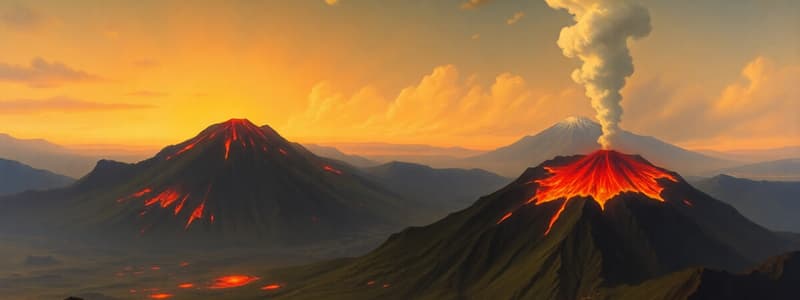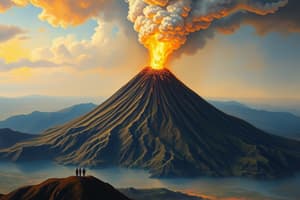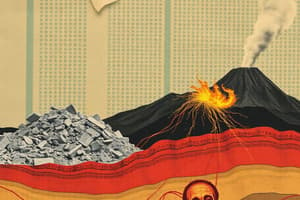Podcast
Questions and Answers
What is a volcano?
What is a volcano?
- A mountain formed by erosion
- A rupture in a planet's crust allowing escape of lava, ash, and gases (correct)
- A deep ocean trench
- A large crater caused by an asteroid impact
What is the main reason for the existence of volcanoes on Earth?
What is the main reason for the existence of volcanoes on Earth?
- Erosion from wind and rain
- The Earth's crust being broken into tectonic plates (correct)
- Constant asteroid impacts
- The presence of a solid, unbroken crust
Where are volcanoes most commonly found?
Where are volcanoes most commonly found?
- In the center of continents
- Where tectonic plates slide past each other
- At the north and south poles
- Where tectonic plates are diverging or converging (correct)
Which geological feature can lead to the formation of volcanoes?
Which geological feature can lead to the formation of volcanoes?
Which type of volcano has a broad, gently sloping shape?
Which type of volcano has a broad, gently sloping shape?
What characterizes composite volcanoes?
What characterizes composite volcanoes?
What is the simplest type of volcano?
What is the simplest type of volcano?
What type of volcanic activity involves steady lava flow?
What type of volcanic activity involves steady lava flow?
Which term describes a volcano that has erupted in the past 10,000 years?
Which term describes a volcano that has erupted in the past 10,000 years?
What is a dormant volcano?
What is a dormant volcano?
What is the term for a volcano that is not expected to erupt again?
What is the term for a volcano that is not expected to erupt again?
What does the Volcanic Explosivity Index (VEI) measure?
What does the Volcanic Explosivity Index (VEI) measure?
Which of these is a volcanic hazard?
Which of these is a volcanic hazard?
What are lahars?
What are lahars?
Which of the following is a positive impact of volcanoes?
Which of the following is a positive impact of volcanoes?
What is one method used to monitor volcanoes?
What is one method used to monitor volcanoes?
Which Italian volcano is known for its destruction of Pompeii?
Which Italian volcano is known for its destruction of Pompeii?
What is one way volcanic eruptions can impact climate?
What is one way volcanic eruptions can impact climate?
What is the study of volcanoes called?
What is the study of volcanoes called?
On which planet is Olympus Mons, a very large volcano, located?
On which planet is Olympus Mons, a very large volcano, located?
What can some volcanic eruptions trigger?
What can some volcanic eruptions trigger?
Which of these gases is commonly emitted by volcanoes?
Which of these gases is commonly emitted by volcanoes?
What is molten rock beneath the Earth's surface called?
What is molten rock beneath the Earth's surface called?
What are pyroclastic flows?
What are pyroclastic flows?
What is volcanic ash composed of?
What is volcanic ash composed of?
What are large volcanic depressions formed by the collapse of a volcano called?
What are large volcanic depressions formed by the collapse of a volcano called?
Where does much of the world's volcanic activity occur?
Where does much of the world's volcanic activity occur?
Which island chain was formed by a hotspot?
Which island chain was formed by a hotspot?
What natural resource can volcanoes be used as a source of?
What natural resource can volcanoes be used as a source of?
What is the purpose of monitoring volcanic activity?
What is the purpose of monitoring volcanic activity?
Flashcards
What is a volcano?
What is a volcano?
A rupture in a planetary crust allowing hot lava, ash, and gases to escape from a magma chamber.
Why do volcanoes occur?
Why do volcanoes occur?
Earth's crust is broken into tectonic plates that float on a hotter, softer layer in its mantle.
What are shield volcanoes?
What are shield volcanoes?
Characterized by large size and low profile, resembling a warrior's shield.
What are composite volcanoes?
What are composite volcanoes?
Signup and view all the flashcards
What are cinder cones?
What are cinder cones?
Signup and view all the flashcards
What is an effusive eruption?
What is an effusive eruption?
Signup and view all the flashcards
What is an explosive eruption?
What is an explosive eruption?
Signup and view all the flashcards
What are active volcanoes?
What are active volcanoes?
Signup and view all the flashcards
What are dormant volcanoes?
What are dormant volcanoes?
Signup and view all the flashcards
What are extinct volcanoes?
What are extinct volcanoes?
Signup and view all the flashcards
What is the Volcanic Explosivity Index (VEI)?
What is the Volcanic Explosivity Index (VEI)?
Signup and view all the flashcards
What are pyroclastic flows?
What are pyroclastic flows?
Signup and view all the flashcards
What are lahars?
What are lahars?
Signup and view all the flashcards
What is volcanic ash?
What is volcanic ash?
Signup and view all the flashcards
What are calderas?
What are calderas?
Signup and view all the flashcards
What is magma?
What is magma?
Signup and view all the flashcards
What is lava?
What is lava?
Signup and view all the flashcards
What are hydrothermal vents?
What are hydrothermal vents?
Signup and view all the flashcards
What is the Ring of Fire?
What is the Ring of Fire?
Signup and view all the flashcards
What is the Cascade Volcanic Arc?
What is the Cascade Volcanic Arc?
Signup and view all the flashcards
Why monitor volcanoes?
Why monitor volcanoes?
Signup and view all the flashcards
What are volcano monitoring strategies?
What are volcano monitoring strategies?
Signup and view all the flashcards
What is Volcanology?
What is Volcanology?
Signup and view all the flashcards
How do volcanoes affect climate?
How do volcanoes affect climate?
Signup and view all the flashcards
How does sulfur dioxide affect climate?
How does sulfur dioxide affect climate?
Signup and view all the flashcards
How are the Cascade volcanoes formed?
How are the Cascade volcanoes formed?
Signup and view all the flashcards
Why monitor volcanic acitivity?
Why monitor volcanic acitivity?
Signup and view all the flashcards
How do volcanoes contribute towards climate change?
How do volcanoes contribute towards climate change?
Signup and view all the flashcards
What is IAVCEI?
What is IAVCEI?
Signup and view all the flashcards
Volcanoes and Climate change
Volcanoes and Climate change
Signup and view all the flashcards
Study Notes
- A volcano is a rupture in the crust of a planetary-mass object, such as Earth, that allows hot lava, volcanic ash, and gases to escape from a magma chamber below the surface.
- Earth's volcanoes occur because its crust is broken into 17 major and many smaller tectonic plates that float on a hotter, softer layer in its mantle.
- Volcanoes are often found where tectonic plates are diverging or converging, and most are found underwater.
- Volcanoes can also form where there is stretching and thinning of the Earth's crust's plates, such as in the East African Rift.
- Volcanoes are usually not found where two tectonic plates slide past one another.
- Volcanoes can be described by their structure, activity, or eruptive history.
- Shield volcanoes are characterized by their large size and low profile, resembling a warrior's shield.
- Composite volcanoes, also known as stratovolcanoes, have steep profiles and periodic explosive eruptions.
- Cinder cones are the simplest type of volcano, formed from accumulation of ejected lava fragments.
- Volcanic activity includes effusive eruptions, where lava flows steadily, and explosive eruptions, which are more hazardous due to the forceful ejection of ash and pyroclastic material.
- Active volcanoes have had at least one eruption during the past 10,000 years.
- Dormant volcanoes have not erupted recently but are expected to erupt in the future.
- Extinct volcanoes are not expected to erupt again.
- All three volcano labels are difficult to define with certainty.
- The volcanic explosivity index (VEI) is a scale that measures the explosivity of volcanic eruptions.
- Volcanoes pose numerous hazards, including ashfall, pyroclastic flows, lahars (mudflows), toxic gases, and tsunamis.
- Volcanoes can also have positive impacts, creating fertile soils, geothermal energy, and unique landscapes.
- Monitoring volcanoes is essential for forecasting eruptions and mitigating risks.
- Strategies include seismic monitoring, gas monitoring, deformation measurements, and thermal imaging.
- Notable volcanoes include Mount Vesuvius (Italy), known for its destruction of Pompeii; Mount St. Helens (USA), site of a major eruption in 1980; and Kilauea (Hawaii), one of the world's most active volcanoes.
- Volcanic eruptions can significantly impact climate by releasing gases and particles into the atmosphere.
- Sulfur dioxide can form sulfate aerosols, which reflect sunlight and cool the planet.
- Volcanic ash can also have a short-term cooling effect.
- The study of volcanoes is known as volcanology.
- Volcanologists study the formation, activity, and products of volcanoes to understand volcanic processes and hazards.
- Volcanoes exist on other planets and moons in our solar system, such as Mars (Olympus Mons) and Io (Jupiter's moon).
- These extraterrestrial volcanoes provide insights into the geological processes of other celestial bodies.
- Volcanic eruptions can trigger tsunamis if they occur near or under the ocean.
- The collapse of a volcano into the ocean can also generate a tsunami.
- Certain types of volcanic eruptions are more likely to cause tsunamis than others.
- Volcanic gases include water vapor, carbon dioxide, sulfur dioxide, and hydrogen sulfide.
- These gases can be harmful to human health and the environment.
- Monitoring gas emissions can provide clues about the state of a volcano and the likelihood of an eruption.
- Magma is molten rock beneath the Earth's surface, while lava is molten rock that has erupted onto the surface.
- The composition of magma and lava varies depending on the volcano and the tectonic setting.
- Different magma compositions result in different eruption styles and volcano types.
- Pyroclastic flows are hot, fast-moving currents of gas and volcanic debris.
- They are one of the most dangerous volcanic hazards.
- Pyroclastic flows can travel at speeds of up to hundreds of kilometers per hour and reach temperatures of hundreds of degrees Celsius.
- Lahars are mudflows composed of volcanic ash, rock, and water.
- They can be triggered by rainfall, snowmelt, or the breaching of a crater lake.
- Lahars can travel long distances and bury or destroy anything in their path.
- Volcanic ash is composed of tiny fragments of rock, mineral crystals, and volcanic glass.
- It can be harmful to human health, damage infrastructure, and disrupt air travel.
- Volcanic ash can travel long distances and affect areas far from the volcano.
- Calderas are large volcanic depressions formed by the collapse of a volcano after a major eruption.
- Calderas can be several kilometers in diameter and hundreds of meters deep.
- Crater Lake in Oregon (USA) is an example of a caldera that has filled with water.
- Hydrothermal vents are openings in the Earth's surface that emit hot, chemically rich water.
- They are often found near volcanoes and in areas of active volcanism.
- Hydrothermal vents support unique ecosystems of organisms that thrive in the absence of sunlight.
- The Ring of Fire is a major area in the basin of the Pacific Ocean where many earthquakes and volcanic eruptions occur.
- The Ring of Fire is associated with a nearly continuous series of oceanic trenches, volcanic arcs, and volcanic belts and plate movements.
- It is home to 75% of the world's volcanoes - more than 450 volcanoes.
- The Cascade Volcanic Arc is a chain of volcanoes in the Pacific Northwest region of North America.
- It includes Mount St. Helens, Mount Rainier, and Mount Hood
- The volcanoes of the Cascade Volcanic Arc are formed by the subduction of the Juan de Fuca Plate beneath the North American Plate.
- The Hawaiian Islands are a chain of volcanoes in the Pacific Ocean.
- They were formed by a hotspot, a plume of hot mantle material that rises to the surface of the Earth.
- Kilauea and Mauna Loa are two of the most active volcanoes in the world.
- Yellowstone National Park (USA) is located above a large volcanic caldera.
- The Yellowstone caldera has experienced several major eruptions in the past.
- The hot springs and geysers in Yellowstone are evidence of the underlying volcanic activity.
- Volcanoes national park in Rwanda protects the steep slopes of this magnificent mountain range - home to the endangered mountain gorilla and a rich mosaic of montane ecosystems, which embrace evergreen forest, bamboo forest, open grassland, swamp and heath.
- Volcanoes can create new land, such as the island of Surtsey, which formed off the coast of Iceland in the 1960s.
- Volcanic eruptions can also destroy existing land and create new geological features.
- The study of ancient volcanic eruptions can provide insights into the history of the Earth and the evolution of the planet.
- Volcanoes have played a significant role in human history and culture.
- They have been both feared and revered by different societies.
- Volcanic eruptions have inspired myths, legends, and works of art.
- Volcanoes can be used as a source of geothermal energy.
- Geothermal energy is a renewable resource that can be used to generate electricity and heat buildings.
- Iceland is a leader in the use of geothermal energy.
- Monitoring of volcanic activity provides essential data to inform timely warnings of impending eruptions.
- Timely warnings of impending eruptions can allow communities to prepare and evacuate, reducing the risk of casualties.
- Remote sensing technologies, such as satellites and drones, are increasingly being used to monitor volcanoes.
- These technologies can provide valuable data on volcanic activity, even in remote or inaccessible areas.
- Volcanoes and climate change are interconnected in several ways.
- Volcanic eruptions can release greenhouse gases into the atmosphere, contributing to climate change.
- Climate change can also affect volcanic activity, for example, by melting glaciers and changing the stability of volcanoes.
- The International Association of Volcanology and Chemistry of the Earth's Interior (IAVCEI) is a scientific organization that promotes research in volcanology and related fields.
- IAVCEI organizes conferences and workshops, publishes journals, and supports international collaborations.
- Volcanoes are both a destructive and constructive force, shaping the Earth's surface and influencing its climate and environment.
- Volcanoes continue to be a subject of intense scientific study and public interest.
Studying That Suits You
Use AI to generate personalized quizzes and flashcards to suit your learning preferences.



